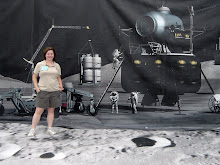Sorry for being lax this month. I am on my way back from my second Athena Science Team meeting. These meetings are giant science festivals, where people present ideas, works in progress, and results from recent experiments and observations. Even if you've been keeping up with the rovers' daily observations, its still difficult to get the bigger picture sometimes, so these meetings are very very useful. There were a couple of sets of presentations about questions that gnaw at us all - what is Home Plate? What is the structure of the Columbia Hills? How do rocks weather on Mars? How old is Victoria Crater? I gave a presentation about Gusev crater, its formation & structure, and how its central peak might underlie the expression of the Columbia Hills (really speculative). When we get the whole team together, it generates some fantastic discussion and really gets me jazzed for working on this amazing dataset!
This summer, I've been focusing on trying to understand Martian impact glass. A couple of the rock types in the Columbia Hills appear to have a glass component in some of the infrared spectra. But, when glassy rocks form on the Earth, they are very easily altered and weathered away. So, it's a little bit of a paradox as to why ancient Martian rock that look weathered still have glass in them. Plus, we don't really understand what the glass is or how much is there. Fortunately for us, we have a couple of examples of Martian glass here on Earth contained in the Martian meteorites. It may not be exactly the same glass, or even formed the same way, but I can do a lot more with a sample in my lab than the rovers can do on the surface. So, I'm trying to characterize the meteorite glass using various lab methods and compare it with our rock data from the mission. I'll be presenting my progress so far at two meetings in August: the Meteoritical Society meeting in Zurich and the International Astronomical Union in Prague. Yes, it's a rough life I lead this summer :)
Thursday, July 27, 2006
Subscribe to:
Posts (Atom)
